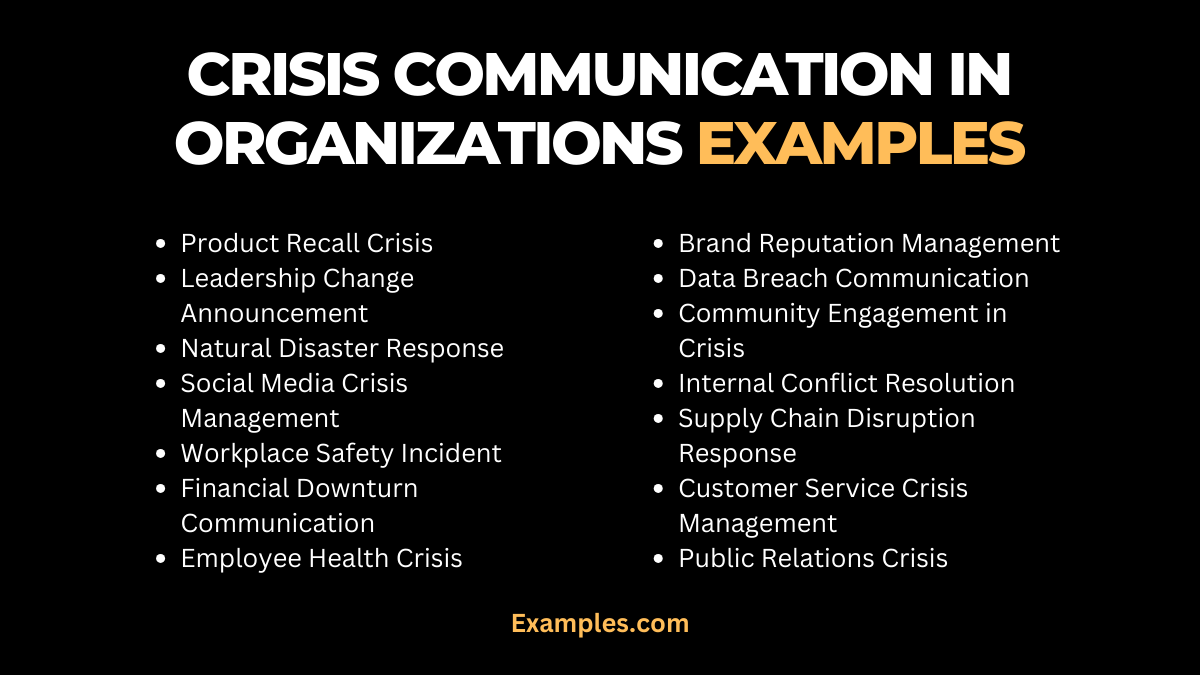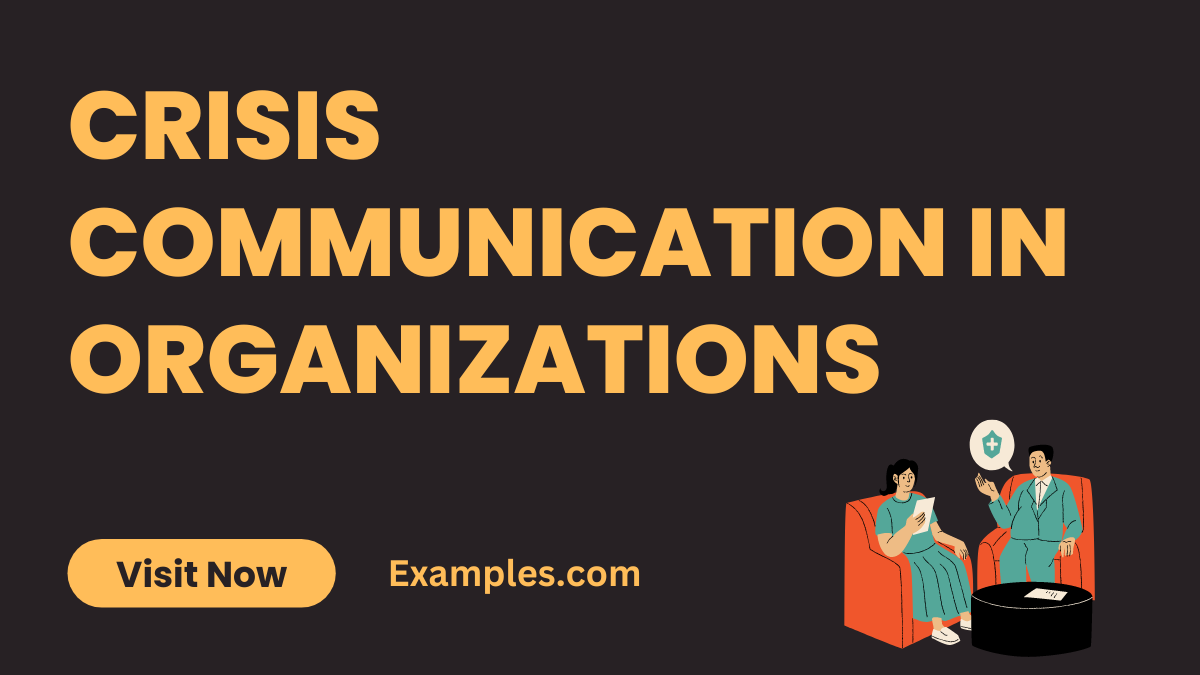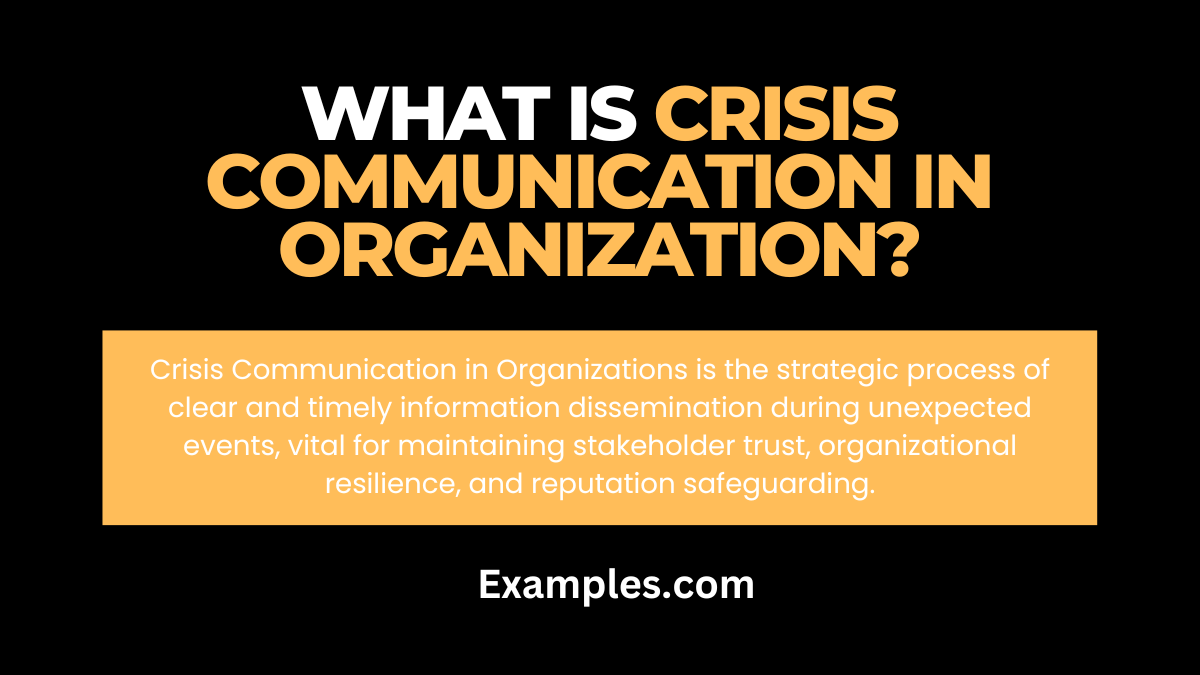19+ Crisis Communication in Organizations Examples
Dive into the comprehensive world of Crisis Communication in Organizations with our guide, enriched with real-world Communication Examples. Navigating uncertainties strategically, this guide empowers you with essential tips and showcases effective examples to bolster your crisis communication strategy. Whether you’re facing challenges or proactively preparing, discover the key to maintaining resilience and trust in organizational communications.
What is Crisis Communication in Organizations?
Crisis Communication in Organizations refers to the strategic and deliberate process of managing and disseminating information during unexpected events or challenges. In simple terms, it involves clear and timely communication to address uncertainties, ensuring stakeholders stay informed, trust is maintained, and the organization remains resilient. This strategic approach is crucial for safeguarding the reputation and stability of organizations during times of crisis.
What is the Best Example of Crisis Communication in Organizations?

One standout example of Crisis Communication in Organizations is Johnson & Johnson’s response to the 1982 Tylenol poisoning crisis. Faced with a life-threatening situation due to product tampering, the company swiftly recalled all Tylenol products nationwide. Prioritizing public safety, they collaborated transparently with authorities, introduced tamper-evident packaging, setting a gold standard for ethical and transparent communication in business crises. This exemplary case underscores the pivotal role of immediate, open, and responsible crisis management.
20 Crisis Communication in Organizations Examples

Explore 20 exemplary instances of Crisis Communication in Organizations, each illustrating strategic resilience and effective communication. These real-world examples showcase the power of proactive crisis management.
- Product Recall Crisis:
- Swiftly announce recalls, prioritize public safety. “Urgent product recall due to safety concerns; prioritizing public safety with immediate communication.”
- Leadership Change Announcement:
- Transparently address changes, ensure continuity. “Announcing leadership changes with transparency, emphasizing continuity and positive outlook.”
- Natural Disaster Response:
- Provide updates, offer support measures. “Responding to natural disasters; regular updates and support measures for affected stakeholders.”
- Social Media Crisis Management:
- Address issues on social media promptly. “Effective social media crisis management; addressing issues promptly and transparently.”
- Workplace Safety Incident:
- Immediate communication, detailed safety measures. “Responding to workplace safety incidents; immediate communication and safety protocols in place.”
- Financial Downturn Communication:
- Transparently address financial challenges. “Navigating financial downturn; transparent communication and outlining support measures.”
- Employee Health Crisis:
- Prioritize health, communicate safety measures. “Addressing employee health crisis; prioritizing health and communicating stringent safety measures.”
- Brand Reputation Management:
- Swiftly respond to protect brand image. “Effective brand reputation management; swift responses to protect brand image during crises.”
- Data Breach Communication:
- Notify affected parties, outline security measures. “Managing data breaches; immediate notification and outlining enhanced security measures.”
- Community Engagement in Crisis:
- Collaborate transparently with stakeholders. “Engaging with the community during crises; transparent collaboration with stakeholders for effective solutions.”
- Internal Conflict Resolution:
- Resolve conflicts transparently. “Addressing internal conflicts; transparent communication for fair and supportive resolution.”
- Supply Chain Disruption Response:
- Communicate alternative solutions promptly. “Navigating supply chain disruptions; prompt communication and offering alternative solutions.”
- Customer Service Crisis Management:
- Address service issues with empathy. “Managing customer service crises; empathetic communication to address and resolve issues promptly.”
- Public Relations Crisis:
- Control the narrative effectively. “Navigating public relations crises; strategic communication to control the narrative and protect reputation.”
- Merger and Acquisition Communication:
- Provide clarity on changes, reassure stakeholders. “Announcing mergers/acquisitions with clear communication, reassurance on positive changes.”
- Technology Failure Response:
- Acknowledge issues, share troubleshooting steps. “Addressing technology failures; acknowledge issues and provide step-by-step troubleshooting for users.”
- Proactive Product Launch Communication:
- Build anticipation, share features transparently. “Proactively launching products; building anticipation and transparently showcasing features to the audience.”
- Environmental Sustainability Crisis:
- Highlight sustainability efforts, future plans. “Navigating environmental crises; highlighting current sustainability efforts and outlining future plans for improvement.”
- Government Regulatory Compliance:
- Outline compliance measures, reassure stakeholders. “Addressing regulatory compliance issues; outlining stringent measures and reassuring stakeholders of compliance.”
- Strategic Partnership Crisis Management:
- Address challenges, emphasize collaboration benefits. “Navigating crises in strategic partnerships; addressing challenges and emphasizing collaborative benefits for mutual success.”
Crisis Communication in Organizations for Employees Examples
Effectively navigate crises with strategic communication tailored for employees, prioritizing their well-being and fostering a sense of security. Explore diverse examples showcasing resilience and trust-building strategies for a robust workforce.
- Remote Work Transition:
- Guidelines Shared: Detailed guidelines provided to ensure a smooth transition to remote work.
- Health and Safety Measures:
- Protocols Emphasized: Transparent communication on health and safety protocols to prioritize employee well-being.
- Financial Challenges Addressed:
- Support Offered: Comprehensive support communicated to alleviate employee concerns during financial challenges.
- Leadership Communication in Crisis:
- Updates Emphasized: Regular updates and emphasis on leadership support for a united front during challenging times.
- Flexible Work Arrangements:
- Options Presented: Clear communication on flexible work arrangements to accommodate individual needs.
Crisis Communication in Organizations for Resume Examples
Explore examples of effective resume communication during crises, showcasing resilience and adaptability to impress potential employers and secure opportunities.
- Employment Gap Explanation:
- Crafting Narrative: Articulate explanation of employment gaps to showcase adaptability and continuous learning.
- Project Accomplishments Highlight:
- Showcasing Achievements: Highlight project accomplishments to demonstrate valuable contributions and problem-solving skills.
- Skill Development During Crisis:
- Emphasizing Growth: Showcase skill development during crisis periods, emphasizing a commitment to personal and professional growth.
- Remote Work Adaptability:
- Remote Experience Highlighted: Emphasize adaptability to remote work, showcasing successful experiences and achievements in virtual settings.
- Leadership in Crisis Situations:
- Leadership Showcase: Demonstrate leadership skills during crisis situations through effective communication, decision-making, and team management.
How to Improve Crisis Communication in Organizations?
In times of crisis, enhancing communication within organizations is pivotal. Adopting strategic measures can significantly improve crisis communication, fostering resilience and trust. Consider the following steps to fortify your organization’s communication strategy during challenging situations:
- Establish Clear Communication Channels:
- Designate official channels for crisis communication, ensuring information flows seamlessly to all stakeholders.
- Proactive Planning and Preparedness:
- Develop a comprehensive crisis communication plan in advance, outlining roles, responsibilities, and communication protocols.
- Employee Training and Awareness:
- Conduct regular training sessions to equip employees with crisis communication skills and raise awareness about potential challenges.
- Real-time Monitoring and Analysis:
- Implement tools for real-time monitoring of emerging issues, enabling prompt responses and adaptive communication strategies.
- Transparent and Timely Updates:
- Prioritize transparent and timely updates to keep stakeholders informed, building trust and confidence during uncertainties.
- Consistent Messaging Across Platforms:
- Maintain consistency in messaging across various communication platforms to avoid confusion and ensure a unified organizational voice.
- Engage with Stakeholders:
- Actively engage with internal and external stakeholders, seeking feedback and addressing concerns promptly.
- Adapt Communication Style:
- Tailor communication styles to suit the nature of the crisis, demonstrating empathy and understanding of the situation.
- Leverage Technology for Outreach:
- Utilize technology platforms for efficient outreach, leveraging social media, email, and other channels to disseminate critical information.
- Post-Crisis Evaluation and Learning:
- Conduct a thorough evaluation post-crisis, identifying strengths and areas for improvement, and incorporate learnings into future communication strategies.
Tips for Effective Crisis Communication in Organizations?
Effective crisis communication is a nuanced skill that can be honed with strategic tips and considerations. Here are actionable tips to enhance the effectiveness of crisis communication within your organization:
- Establish a Centralized Communication Team:
- Designate a dedicated team responsible for coordinating and disseminating crisis-related communication.
- Prioritize Clarity and Simplicity:
- Craft messages that are clear, concise, and easily understandable, minimizing the risk of misinterpretation.
- Build Trust Through Transparency:
- Foster trust by being transparent about the situation, acknowledging challenges, and communicating genuine efforts to resolve issues.
- Anticipate Potential Questions:
- Anticipate and address potential questions and concerns in your communication to proactively manage expectations.
- Offer Regular Updates:
- Provide regular updates to keep stakeholders informed about the evolving situation, demonstrating a commitment to open communication.
- Tailor Communication to Different Audiences:
- Customize communication for different audiences, considering the needs and concerns of employees, customers, investors, and the broader community.
- Utilize Multichannel Communication:
- Employ a variety of communication channels, including press releases, social media, and internal newsletters, to ensure widespread coverage.
- Activate Spokespersons:
- Designate trusted spokespeople within the organization to convey messages, ensuring consistency and reliability in communication.
- Practice Crisis Scenarios:
- Conduct regular crisis communication drills to prepare teams for real-time challenges, refining strategies based on lessons learned.
- Seek External Counsel:
- When necessary, seek external communication experts or crisis management consultants to provide valuable insights and guidance.
Implementing these tips can fortify your organization’s crisis communication strategy, enabling a more resilient and responsive approach during challenging times.
In conclusion, Crisis Communication in Organizations is a vital strategic process, ensuring clear and timely information dissemination during unexpected events. Through real-world examples like Johnson & Johnson’s Tylenol crisis response, we witness the impact of transparent, swift actions in maintaining trust and organizational resilience. This guide serves as a comprehensive resource for navigating crises, fostering effective communication for organizational stability.




